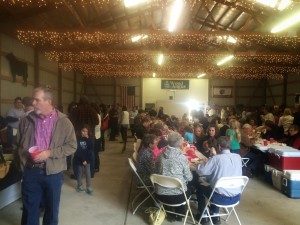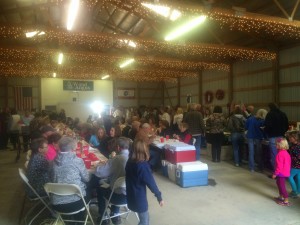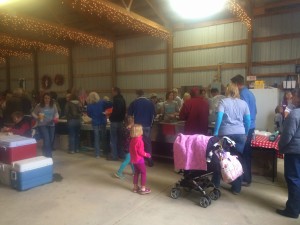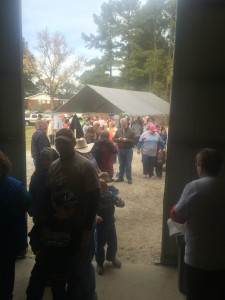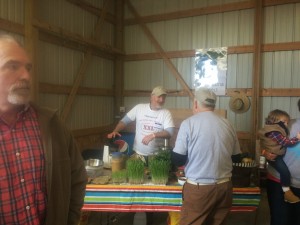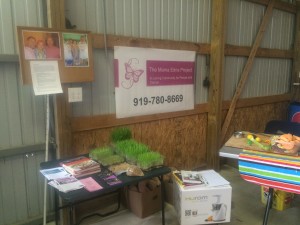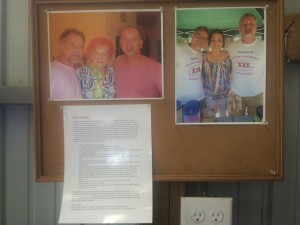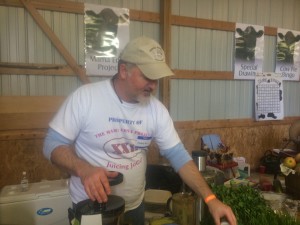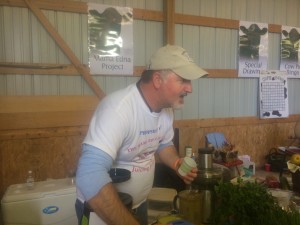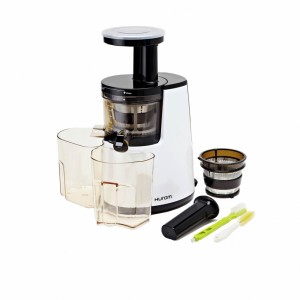Follow Up on the Very Successful Team DeEtta Benefit
by AndrewThe Mama Edna Project shared a link.

Making Bone Broth (very nutritious and sometimes quite a forgotten method)
by AndrewHow to Make Bone Broth
shared from http://www.organicauthority.com/
How to Make Bone Broth (and Why Is it So Healthy?)
November 4, 2014
by Jen Wallace
Energetic Health , Soups
348
With cold and flu season upon us, you might want to learn how to make bone broth so you can stock up on this superliquid. For those, not in the know, bone broth is stock on steroids (not literally, of course). Back before meat and vegetables came already cut up and wrapped in styrofoam and plastic, our grandparents used to make mineral rich bone broth from bones, scraps and other leftover bits. Nothing was allowed to go to waste. Unfortunately, we lost the knowledge to make this nourishing food.
What Is Bone Broth?
Everyone knows what stock is, right? Stock is the base for any good soup or stew made from simmering bits of meat, vegetables and aromatics in water for 4-6 hours. Many people buy already made meat stock from the grocery store, but the homemade stuff is the best. Bone broth is simply stock that is cooked for a much longer period of time–as long as 24-48 hours.
Why Is it So Healthy?
Bone broth is rich in vitamins, minerals, good fats and tissue-restorative collagen. Each bowl of bone broth is a boost to the immune system. Bone broth is a favorite among those who choose to eat the Paleo diet and is also beneficial for those with digestive disorders and autoimmune conditions.
Don’t take my word for it though; read more about why bone broth is considered a superfood from The Paleo Mom, the Whole 9 and Wellness Mama.
How to Make Bone Broth
I make two kinds of bone broth–chicken and beef. The process is the same for both, but the cooking length is different. Chicken bone broth is done after 24 hours of cooking, will beef bone broth needs 48 hours to cook.
Ingredients:
- 2 pounds of good quality beef bones (I usually get knuckles and rib bones from a local butcher. The bones do need to be sliced open to expose the marrow. Ask your butcher to do this).
- 2 carrots, roughly chopped
- 2 stalks of celery, roughly chopped
- 1 onion, roughly chopped (if tolerated)
- fresh herbs like parsley, thyme, rosemary
- 2 tablespoons of apple cider vinegar (helps break down the bones and marrow)
- filtered water
How-to make bone broth:
- Place bones in a crock pot. A slow cooker is necessary because you will be cooking this for stock for 48 hours, and I’m assuming you plan to sleep and leave the house.
- Add carrots, celery, onions and herbs.
- Fill the slow cooker up with water so the bones and vegetables are covered.
- Pour in the apple cider vinegar.
- Turn slow cooker on high for 8 hours. Turn down to low after that.
- Cook for a total of 48 hours.
- Spoon out and discard the vegetables and bones.
- Strain the broth with a fine mesh strainer to catch any bones or other bits you may have missed.
The final product can be stored in freezer safe containers for up to 6 months ( I use mason jars leaving an 1-2 inches of room for the liquid to expand).
To make chicken bone broth, simply substitute chicken bones (they do not need to cut open as they will break down on their own) and cook for 24 hours.
Use in soups or stews, add to mashed potatoes or mashed cauliflower or simply drink a mug in the morning with breakfast.
Cows Hate Cancer, The Team DeEtta Event
by AndrewTimothy McLamb and I were invited to help support the DeEtta Wood Benefit in Willow Springs, NC (JoCo, Johnston County) on Saturday, November 8, 2014. Here is a little glimpse of what we did, although time was scarce for us to do photos. We juiced for over 5 hours and served up samples to an 850 person crowd. What an awesome outpouring of love for DeEtta, as she continues her battle with cancer.
Juicing versus Blending/Smoothies
by AndrewJuicing versus Blending/Smoothies
People often ask: which is better–juicing or blending? When your body is experiencing a crisis like cancer or other degenerative disease, many times your digestive system is also in crisis, making it difficult to get the proper nutrients from food needed to heal. We believe from all the reading we have done that juicing has an favorable advantage over blending when you are trying to heal cancer. Lose the fiber and your body quickly absorbs the nutrients into the blood stream. Yes, you need the fiber, but not in your juice. Eat a well balanced diet the rest of the day. Eat lots of plant-based foods rich in fiber. But leave your juice as JUICE.Or have a smoothie later in the day for a snack. Avoid too much fruit in your juice. One apple or one crisp pear should be your limit to avoid bringing too much sugar into the bloodstream, causing sugar spikes (we know by know that sugar is cancer’s favorite food).
In a nutshell: Blending requires DIGESTION, which is a heat-related activity for your body. Heat, like the heat from a blender or high-speed juicer, can kill off certain enzymes, phytonutrients and micro-nutrients readily available in juiced raw produce. Juicing, with the pulp removed through a slow, masticating juicer like the Hurom juicer, only requires ABSORPTION. Thus, your body can absorb up to 99% of the nutrients in juice.
Here are a few links to help explain the differences.
http://www.foodmatters.tv/juicer-buying-guide
http://www.foodmatters.tv/articles-1/juicing-vs-blending-which-one-is-better
http://juicing-for-health.com/juicer-review/what-to-look-for/juicing-vs-blending.html
http://www.rebootwithjoe.com/juicing-vs-blending-infographic/
Top 10 Foods Highest in Beta Carotene–helps with lung damage
by AndrewTop 10 Foods Highest in Beta Carotene–helps with lung damage
Beta Carotene is being studied in helping to reverse the effects of COPD and lung damage, especially in smokers and former smokers. But the study does say to get it from foods, not from supplements.
Top 10 Foods Highest in Beta Carotene, taken from the link below:
http://www.healthaliciousness.com/articles/natural-food-sources-of-beta-carotene.php
Beta Carotene is a carotenoid compound responsible for giving fruits and vegetables their orange pigment. A powerful antioxidant, beta carotene has been found to help protect against cancer and aging. Beta-carotene is a fat soluble vitamin, so eating the following foods with a fat like olive oil or nuts can help absorption. Below is a list high beta carotene foods, click here for high beta carotene foods by nutrient density, and here for an extended list of beta carotene rich foods
#1: Sweet Potato (Baked)
Beta-carotene in 100g Per cup (200g) Per medium potato (114g) 11509µg 23018µg 13120µg An average sweet potato contains only 103 calories and 0.2 grams of fat. Click to see complete nutrition facts.
#2: Carrots (Cooked)
Beta-carotene in 100g Per 1/2 cup, slices (78g) Per carrot (46g) 8332µg 6499µg 3833µg Half a cup of sliced carrots contains only 27 calories and 0.1 grams of fat. Click to see complete nutrition facts.
#3: Dark Green Leafy Vegetables (Spinach, Cooked)
Beta-carotene in 100g Per cup (180g) Per 1/2 cup (90g) 6288µg 11318µg 5659µg Other Dark Green Leafy Vegetables High in Beta-carotene (amount per cup, cooked): Kale (10625µg), Mustard Greens (10360µg), Collard Greens (8575µg), Beet Greens (6610µg), Turnip Greens (6588µg), Swiss Chard (6391µg), and Pak Choi (4333µg). Click to see complete nutrition facts.
#4: Cos or Romaine Lettuce
Beta-carotene in 100g Per cup, shredded (47g) Per head (626g) 5226µg 2456µg 32714µg Other Types of Lettuce High in Beta-carotene (amount per cup, shredded): Green Leaf (1599µg), Red Leaf (1259µg), Butterhead (1093µg), and Chicory (995µg). Click to see complete nutrition facts.
#5: Squash (Butternut Cooked)
Beta-carotene in 100g Per cup cubes (205g) 4570µg 9369µg Other Types of Squash High in Beta-carotene (amount per cup, cooked): Hubbard Squash, cubed (7339µg), and Pumpkin, mashed (5135µg). Click to see complete nutrition facts.
#6: Cantaloupe Melon
Beta-carotene in 100g Per cup, balls (177g) Per wedge (69g) 2020µg 3575µg 1394µg An average wedge of cantaloupe melon contains only 23 calories and 0.1 grams of fat. Click to see complete nutrition facts.
#7: Sweet Red Peppers
Beta-carotene in 100g 1 cup chopped (149g) 1 large (164g) 1624µg 2420µg 2663µg A large sweet green pepper contains 341µg and a large sweet yellow pepper contains 223µg. Click to see complete nutrition facts.
#8: Dried Apricots
Beta-carotene in 100g Per cup (130g) Per half (4g) 2163µg 2812µg 87µg Other Dried Fruit High in Beta-carotene (amount per cup): Dried Peaches (1718µg) and Prunes (685µg). Click to see complete nutrition facts.
#9: Peas (Cooked)
Beta-carotene in 100g Per 1/2 cup (80g) Per package (253g) 1250µg 1000µg 3163µg Half a cup of peas contains only 62 calories and 0.2 grams of fat. Click to see complete nutrition facts.
#10: Broccoli (Cooked)
Beta-carotene in 100g Per 1/2 cup chopped (78g) Per stalk (180g) 929µg 725µg 1672µg Half a cup of cooked broccoli contains only 27 calories and 0.3 grams of fat. Click to see complete nutrition facts.
Links to Nutritional Information Important to Battling Cancer
by AndrewImportant Links for Nutritional Information While Undergoing Cancer Treatments
Here are some great places to find information on eating clean, healthy diets including juicing, blending, and cooking to either prevent cancer in the first place or to help heal the body before, during and after cancer treatments. We simply are putting out there blogs and sights we find interesting. Please note, we cannot be responsible for the medical viability of any of these sites. We simply review the reviews and share the links that get a wide variety of seemingly good reviews. In the fight against cancer, we must try any and all means to kick cancer to the curb.
TriHealth
http://www.trihealth.com/dailyhealthwire/cancer/Cancer-Fighting-Juicing-Recipes.aspx
Cancer Treatment Centers of America
Food for Life Classes
http://www.pcrm.org/health/diets/ffl/ffl-the-power-of-food-for-health (Locally taught by Dilip Barman http://www.dilip.info/)
Hippocrates Health Institute
The Gerson Institute
Crazy Sexy Wellness
http://kriscarr.com/ (author of Crazy Sexy Cancer Tips)
Integrated Health Institute
http://www.integrativehealthinstitute.ca/
Fit for Life TV/Drew Canole
http://fitlife.tv/ (also on Facebook as Juicing Vegetables)
Reboot With Joe (mostly for the juicing recipes)
The Cancer-Fighting Kitchen (cook book and author Rebecca Katz)
http://rebeccakatz.com/books/the-cancer-fighting-kitchen/ and on Facebook https://www.facebook.com/thecancerfightingkitchen
The Juicing Bible
available at Barnes and Noble Booksellers http://www.barnesandnoble.com/w/juicing-bible-pat-crocker/1102099237?ean=9780778801818
And find us on the web at https://themamaednaproject.com/

